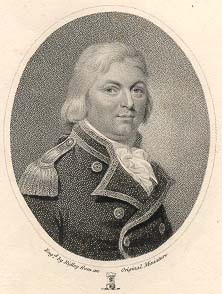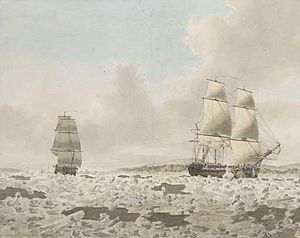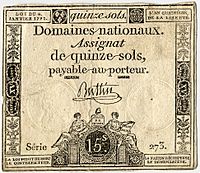Philippe d'Auvergne facts for kids
Quick facts for kids
Philippe d'Auvergne
Prince de Bouillon (by adoption)
|
|
|---|---|
 |
|
| Born | 13 November 1754 Jersey, Channel Islands |
| Died | 18 September 1816 (aged 61) London, England |
| Allegiance | |
| Service/ |
|
| Years of service | 1775 – 1816 |
| Rank | Vice Admiral |
| Battles/wars | |
Philippe d'Auvergne (born November 13, 1754 – died September 18, 1816) was a brave British naval officer. He was also the adopted son of the Duke of Bouillon, a ruler in a region called Wallonia. Philippe had an exciting life in the Royal Navy, serving during major wars and even working as a spy. He faced many challenges, from being a prisoner of war to surviving a shipwreck, all while hoping to become a prince himself!
Contents
Early Life and Education
Philippe d'Auvergne was born on the island of Jersey, where his family had lived for hundreds of years. His mother died when he was born. His father, Charles Dauvergne, was a former British Army officer and an advisor to important government officials.
Philippe went to school in Jersey, England, and France. He was very good at languages, speaking both French and English fluently. He also had a strong interest in mathematics and science. Growing up, he spent a lot of time sailing around the coast of Jersey.
Philippe d'Auvergne joined the Royal Navy in 1770 as a midshipman, which is a junior officer rank. He trained on the Royal Yacht HMS Mary, a special training ship for selected young men. This was an easier way to learn than on a regular warship. It's believed that Earl Howe, a high-ranking naval officer, helped Philippe get this special training because he was friends with Philippe's father.
Later, Philippe served on HMS Flora. During this time, he continued to study mathematics. He tried to solve difficult problems like how to keep accurate time and measure air pressure while at sea.
Arctic Adventure

In 1773, the British Navy sent an expedition to the Arctic. The goal was to explore and gather scientific knowledge. Two ships, Carcass and Racehorse, sailed north on June 4, 1773.
Philippe d'Auvergne was a midshipman on the Racehorse. On the other ship, Carcass, was another young midshipman who would become very famous: 15-year-old Horatio Nelson.
The expedition didn't find the Northwest Passage, a sea route through the Arctic. However, they sailed further north than any previous journey. This, along with their scientific discoveries, made the expedition a success. Philippe even drew sketches for the expedition's official journal.
American War of Independence
By 1775, d'Auvergne was serving on HMS Asia near Boston Harbour. The ship was there to support British forces fighting against the American colonists.
As a midshipman, Philippe was ordered to lead boats carrying soldiers to attack Lexington. He also watched the Battle of Bunker Hill from his ship. Later, he was part of the force that bombarded and burned Falmouth.
Philippe became an acting Lieutenant and commanded boats during battles around Boston and Manhattan Island. He impressed his commanders and was officially made a Lieutenant in 1777. He was given command of an eight-gun ship called Alarm. He successfully captured an American ship and destroyed a guard house.
When France and Spain joined the American colonies in 1778, French ships entered Rhode Island. Philippe had to follow orders and sink his ship, Alarm, to prevent it from being captured. He was later cleared of any blame for losing his ship.
Captured by the French
After returning to England, d'Auvergne became the First Lieutenant on HMS Arethusa. In March 1779, Arethusa fought a French ship. During the battle, a larger French warship appeared. Arethusa tried to escape but hit a rock near the coast of Molène.
Most of the crew were captured and taken prisoner in Carhaix, France. Philippe d'Auvergne was among them.
Becoming a Prince
While Philippe was a prisoner, something unexpected happened. The Duke of Bouillon, Godefroy Charles Henri de la Tour d'Auvergne, was looking for someone to adopt. His only son was disabled and couldn't have children, so the Duke needed an heir.
A French soldier mentioned that a Philippe d'Auvergne was being held prisoner. The Duke was curious and arranged for Philippe to visit him in February 1780. Philippe, speaking fluent French, told the Duke about his adventures. The Duke liked him very much.
Philippe was sent back to prison but was soon exchanged for French prisoners and returned to England. The Duke hired experts to research Philippe's family history and connect the Jersey d'Auvergnes to the French princely family.
In 1780, Philippe was given command of HMS Lark. In 1781, his ship sailed as part of a British fleet sent to attack the Cape of Good Hope, a Dutch colony. The British wanted to punish the Dutch for their alliance with France.
At Porto Praya, the British fleet was attacked by a French fleet. The battle was not decisive, and the French managed to reach the Cape first. The British failed to capture the Cape but did capture some Dutch merchant ships in Saldanha Bay. Philippe d'Auvergne provided important information that helped capture these ships, and his commander praised him as a "very promising young officer."
Shipwrecked on an Island
Philippe was promoted in August 1781 and took command of HMS Rattlesnake. His ship, along with Jupiter, was sent to survey Trindade and Martim Vaz, a group of volcanic islands, to see if they could be used as a naval base.
On October 21, 1781, during a heavy storm, Rattlesnake lost its anchor and crashed into a rock. Philippe and 30 sailors, 20 captured French sailors, one woman, and some animals were stranded on the tiny island.
A supply ship arrived in January 1782, but then the castaways were forgotten. Philippe and his group remained on the island until December 27, 1782. By chance, HMS Bristol passed by, and Philippe fired distress signals. The ship rescued everyone and took them to Madras, India. Philippe was again cleared of any blame for the loss of his ship and was praised for his leadership during the difficult time.
Peace and Royal Society
After returning to England, d'Auvergne was promoted to Post-captain. However, the peace with France meant fewer ships were needed, so he was put on half pay.
Between 1784 and 1787, Philippe traveled and studied. He earned an honorary degree and became a member of the Royal Society, a famous group for scientists, in 1786. He also worked as a Revenue officer in Jersey for a few years.
In 1787, the adoption by the Duke of Bouillon was officially approved by King George III. Philippe d'Auvergne was now known as the Prince of Bouillon. He would become the Duke if the Duke's son died without an heir. Philippe refused an offer to become a French citizen, saying he would never betray his own country. In 1792, King George III confirmed Philippe as the Prince-Successor.
French Revolution and Espionage
When the French Revolution began in 1793, d'Auvergne was in London. He was soon given command of a group of gunboats in Jersey. These ships were not strong warships, but small converted vessels. The crews were mainly from Jersey, as English sailors didn't want to serve on them.
In September 1794, d'Auvergne was given an important new role. He was to command the ships protecting the Channel Islands and gather information about enemy movements. He also had to communicate with French Royalists who were fighting against the Revolution. He helped distribute money and supplies to thousands of French people who had fled to Jersey. He even set up a school for their children.
Spymaster in the Revolution
The British government gave d'Auvergne a large amount of money each month for secret operations. He used this money to cause trouble in France. He managed a network of spies and rebels, smuggling weapons, ammunition, and supplies into France. They even smuggled fake French paper money, called Assignat, which caused huge inflation in France.
Jersey was a perfect base for d'Auvergne. He built a signal station on a tower he owned at La Hougue Bie, which could be seen from the French coast. This helped with secret communications. He also used Mont Orgueil castle as a base for his operations. Messages were sometimes hidden in lobster pots or on isolated rocks for French fishermen to pick up.
D'Auvergne also supported a British and Royalist attempt to invade France at Quiberon in 1795. The invasion failed, and many Royalist soldiers were executed.
A frequent visitor to Jersey was Georges Cadoudal, a leader of the Royalist rebels. Cadoudal was involved in an attempt to assassinate Napoleon Bonaparte in Paris in 1800. A bomb exploded too late, and Napoleon was only slightly injured.
Claims to the Bouillon Throne
First Claim
With peace returning, d'Auvergne lost his command in Jersey. He spent his time at his home on Jersey, developing a unique neo-Gothic building called the Prince's Tower at La Hougue Bie. His library held 4,000 books on various subjects. He was promoted to Vice Admiral of the Red.
In 1795, the French took over the Duchy of Bouillon. The Duke, Godefroy III, died in 1794, and his son Jacques Leopold became Duke. Jacques Leopold died in 1802 without children. Philippe d'Auvergne then began using the full title of Duke of Bouillon.
After a peace treaty in 1802, d'Auvergne went to Paris to claim his title. However, the French police, knowing about his spy activities, arrested him without explanation and threw him in jail. He was held for five days and then given only 24 hours to leave France. Questions were raised in the British Parliament, but no further action was taken to avoid upsetting the peace.
Spymaster in the Napoleonic Era
D'Auvergne returned to Jersey. By 1802, many French people who had fled during the Revolution were allowed to return home by Napoleon Bonaparte. However, d'Auvergne continued to gather secret information from France, including details about Napoleon's plans to invade Britain.
His network of spies slowly disappeared as they were captured or chose to support Napoleon. In 1803, he was given HMS Severn to help defend Jersey, but the ship was wrecked in a storm the next year.
Some spies continued their dangerous missions. In 1807, d'Auvergne sent agents to France to check on a possible new rebellion. However, they found no support. One spy, Bouchard, was captured and revealed everything he knew about d'Auvergne's spy network. Bouchard then tricked d'Auvergne into sending more agents to France, who were immediately arrested and executed. Any hope of a new Royalist uprising faded.
In 1808, d'Auvergne was promoted to Rear-Admiral. In 1809, Napoleon ordered the confiscation of all the Bouillon family's property. Philippe was promoted to Vice-Admiral but stepped down from his role in 1812, possibly due to poor health.
Second Claim to the Throne
In 1814, the French monarchy was restored, and King Louis XVIII came to power. When d'Auvergne visited him, the King agreed to support Philippe's claim to the Duchy of Bouillon because of all his help to the Royalists. Philippe was formally declared Prince of Bouillon.
In 1815, when Napoleon returned to power, d'Auvergne went to Brussels and even formed a small regiment to fight. However, just before the Battle of Waterloo, he learned that the Congress of Vienna had decided to give the Duchy of Bouillon to the United Kingdom of the Netherlands. This meant there would be no independent principality for him to rule.
Another person, Prince Charles de Rohan, also claimed the throne. The Congress of Vienna decided that the King of the Netherlands should rule on the case. The King eventually decided in favor of Rohan, who had a closer blood relation to the previous Duke.
Later Life and Death
Philippe d'Auvergne returned to London. He had lost his money and was bankrupt. He died on September 18, 1816.
Most of his titles, like Duke of Bouillon and Viscount of Turenne, ended with his death. His personal belongings and library were sold at auction. The Duchy of Bouillon remained complicated until 1825, when its lands were divided among different families.
Images for kids




